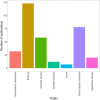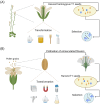A comprehensive review of in planta stable transformation strategies
- PMID: 38822403
- PMCID: PMC11140912
- DOI: 10.1186/s13007-024-01200-8
A comprehensive review of in planta stable transformation strategies
Erratum in
-
Correction: A comprehensive review of in planta stable transformation strategies.Plant Methods. 2024 Oct 15;20(1):158. doi: 10.1186/s13007-024-01282-4. Plant Methods. 2024. PMID: 39402672 Free PMC article. No abstract available.
Abstract
Plant transformation remains a major bottleneck to the improvement of plant science, both on fundamental and practical levels. The recalcitrant nature of most commercial and minor crops to genetic transformation slows scientific progress for a large range of crops that are essential for food security on a global scale. Over the years, novel stable transformation strategies loosely grouped under the term "in planta" have been proposed and validated in a large number of model (e.g. Arabidopsis and rice), major (e.g. wheat and soybean) and minor (e.g. chickpea and lablab bean) species. The in planta approach is revolutionary as it is considered genotype-independent, technically simple (i.e. devoid of or with minimal tissue culture steps), affordable, and easy to implement in a broad range of experimental settings. In this article, we reviewed and categorized over 300 research articles, patents, theses, and videos demonstrating the applicability of different in planta transformation strategies in 105 different genera across 139 plant species. To support this review process, we propose a classification system for the in planta techniques based on five categories and a new nomenclature for more than 30 different in planta techniques. In complement to this, we clarified some grey areas regarding the in planta conceptual framework and provided insights regarding the past, current, and future scientific impacts of these techniques. To support the diffusion of this concept across the community, this review article will serve as an introductory point for an online compendium about in planta transformation strategies that will be available to all scientists. By expanding our knowledge about in planta transformation, we can find innovative approaches to unlock the full potential of plants, support the growth of scientific knowledge, and stimulate an equitable development of plant research in all countries and institutions.
Keywords: Direct organogenesis; In planta transformation; In situ transformation; In vivo regeneration; Indirect organogenesis; Recalcitrant species.
© 2024. The Author(s).
Conflict of interest statement
The authors declare no competing interests.
Figures









Similar articles
-
Crop genome editing through tissue-culture-independent transformation methods.Front Genome Ed. 2024 Dec 5;6:1490295. doi: 10.3389/fgeed.2024.1490295. eCollection 2024. Front Genome Ed. 2024. PMID: 39703881 Free PMC article. Review.
-
A Genotype-Independent, Simple, Effective and Efficient in Planta Agrobacterium-Mediated Genetic Transformation Protocol.Methods Protoc. 2022 Sep 3;5(5):69. doi: 10.3390/mps5050069. Methods Protoc. 2022. PMID: 36136815 Free PMC article.
-
An Apical Meristem-Targeted in planta Transformation Method for the Development of Transgenics in Flax (Linum usitatissimum): Optimization and Validation.Front Plant Sci. 2021 Jan 28;11:562056. doi: 10.3389/fpls.2020.562056. eCollection 2020. Front Plant Sci. 2021. PMID: 33584740 Free PMC article.
-
Development of high-throughput tissue culture-free plant transformation systems.Plant J. 2025 Jan;121(1):e17163. doi: 10.1111/tpj.17163. Epub 2024 Dec 9. Plant J. 2025. PMID: 39652509 Free PMC article. Review.
-
Optimization of in planta methodology for genome editing and transformation in Citrus.Front Plant Sci. 2024 Jul 12;15:1438031. doi: 10.3389/fpls.2024.1438031. eCollection 2024. Front Plant Sci. 2024. PMID: 39070914 Free PMC article.
Cited by
-
Unlocking the power of antimicrobial peptides: advances in production, optimization, and therapeutics.Front Cell Infect Microbiol. 2025 Apr 28;15:1528583. doi: 10.3389/fcimb.2025.1528583. eCollection 2025. Front Cell Infect Microbiol. 2025. PMID: 40365533 Free PMC article. Review.
-
Taming the wild: domesticating untapped northern fruit tree and shrub resources in the era of high-throughput technologies.AoB Plants. 2025 Jan 4;17(1):plae074. doi: 10.1093/aobpla/plae074. eCollection 2025 Jan. AoB Plants. 2025. PMID: 39886049 Free PMC article. Review.
-
Efficient Agrobacterium-Mediated Methods for Transient and Stable Transformation in Common and Tartary Buckwheat.Int J Mol Sci. 2025 May 6;26(9):4425. doi: 10.3390/ijms26094425. Int J Mol Sci. 2025. PMID: 40362662 Free PMC article.
-
Mother transformer: A High-Throughput, Cost-Effective in Planta Hairy Root Transformation Method for Cannabis.BMC Biotechnol. 2025 Jul 1;25(1):60. doi: 10.1186/s12896-025-00990-6. BMC Biotechnol. 2025. PMID: 40598062 Free PMC article.
-
Stable transformation mediated by Agrobacterium tumefaciens in Jonquil is better than Agrobacterium rhizogenes.Front Plant Sci. 2025 Jun 26;16:1594197. doi: 10.3389/fpls.2025.1594197. eCollection 2025. Front Plant Sci. 2025. PMID: 40641867 Free PMC article.
References
-
- Somssich M. A short history of plant transformation. PeerJ Prepr [Internet]. 2019;1:1–28. https://peerj.com/preprints/27556/.
-
- Padole D. Arabidopsis-a model plant. Trends Biosci. 2019;10(February):557–9.
-
- Koornneef M, Meinke D. The development of Arabidopsis as a model plant. Plant J. 2010;61(6):909–21. - PubMed
-
- Kaur RP, Devi S. In planta transformation in plants: a review. Agric Rev. 2019;40(03):159–74.
Publication types
LinkOut - more resources
Full Text Sources
Miscellaneous

